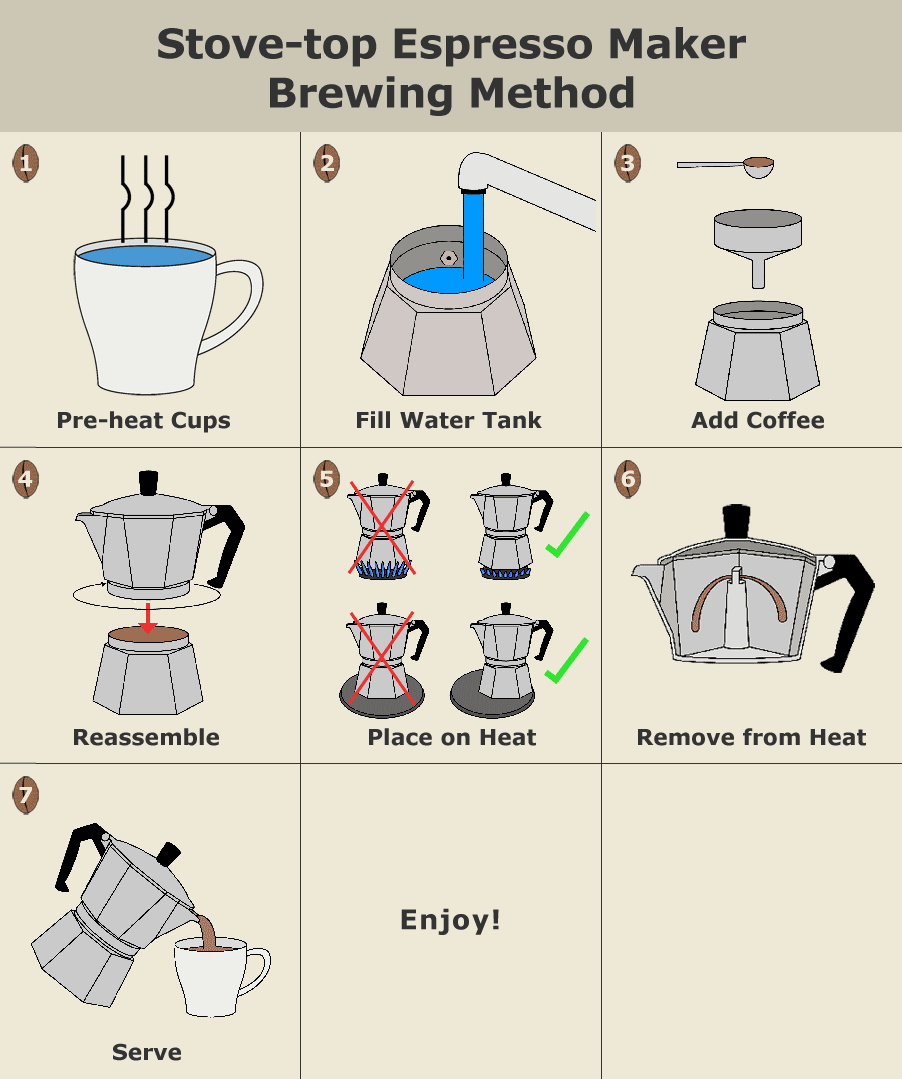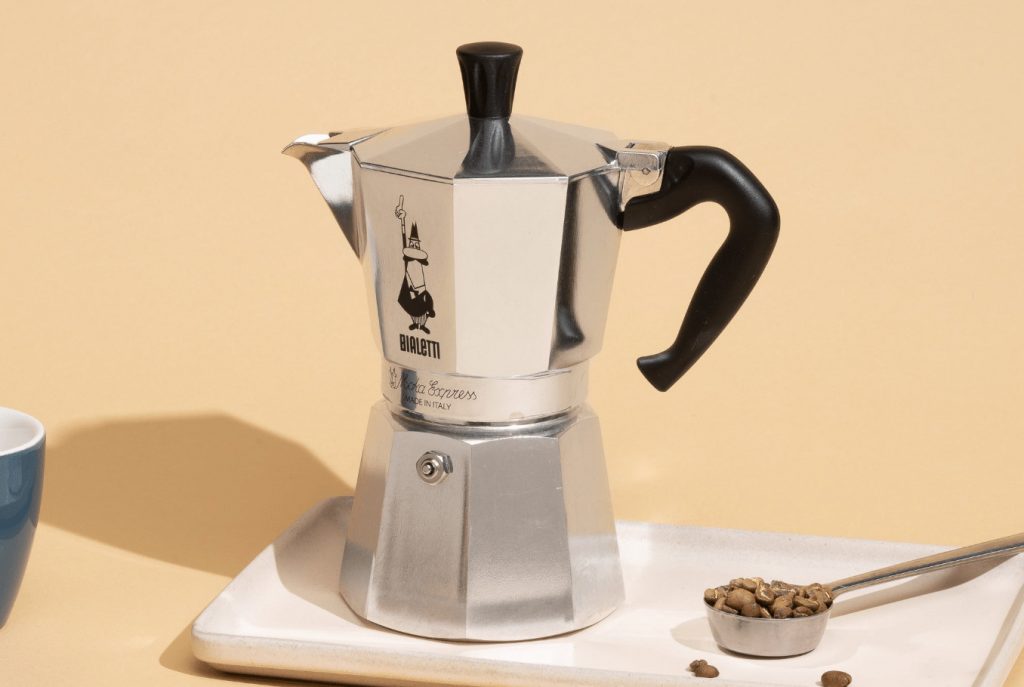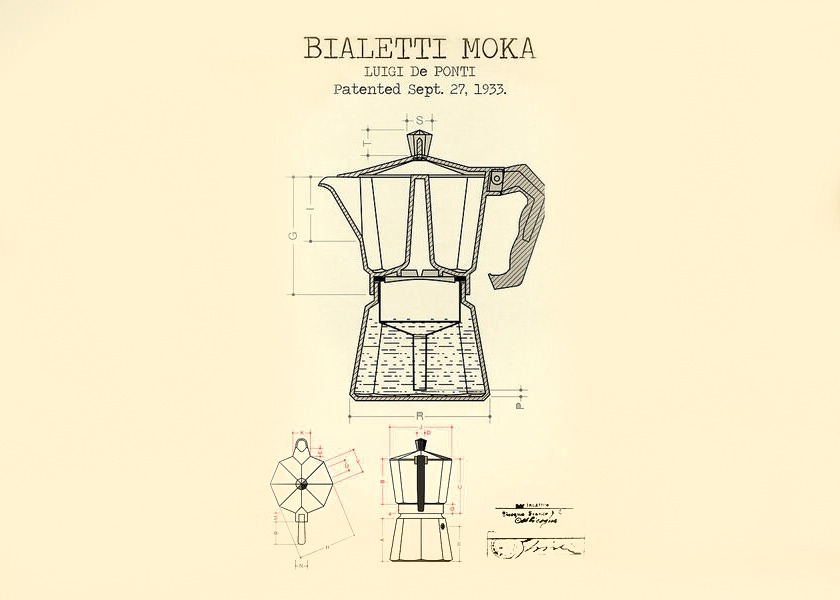When people call a Moka pot the most popular tool for making coffee, they are not wrong.
This instantly recognizable symbol of Italian coffee culture can not only be found in 9 out of 10 Italian kitchens but also in the homes of many deep coffee lovers around the world.
Iconic design, compactness, ease of preparation, affordability and intense taste of home-brewed coffee – are the qualities that have won the hearts of Italian coffee lovers.
The Moka pot, traditionally associated with strong and very hot coffee, is experiencing a renaissance.
The constant experimentation of coffee connoisseurs offers many opportunities to further improve the taste of the coffee and even create popular coffee drinks.
Whether you’re thinking about a Moka pot, have just bought one, or have been using one for years, we invite you to take a closer look at this nearly hundred-year-old coffee tool and find out how you can use it to make delicious coffee.
What Led To The Popularity Of The Espresso Maker?
The mocha pot revolutionized domestic coffee preparation at the time. We owe these espresso makers to Alfonso Bialetti, an engineer from Milan, and Luigi De Ponti, the inventor who worked with him and introduced this innovative device in 1933.
Back then in Italy, the only way to get a strong and delicious coffee was to visit a café with an espresso machine.
The first coffee maker, the Bialetti Moka Express ( which is still in production today ), allowed everyone to enjoy a coffee of similar intensity and flavour at a price that was affordable for many.
And the first espresso makers were sold at the Piedmontese weekly market!
The first word, Moka, pays homage to the legendary Yemeni port city of Moka, which once held the monopoly on coffee exports, and the second word, express, emphasizes the speed of this method of preparation.
The Moka pot became particularly popular after Alfonso Bialetti’s son Renato took over the helm.
It is thanks to him that in the 1960s the famous logo appeared on the Bialetti jugs: a man with a moustache (presumably Renato’s prototype).
This man from the Bialetti family focused on advertising and managed to make this espresso maker an indispensable part of every Italian kitchen.
The main message for coffee lovers is that it’s easy to make delicious coffee at home – all you need is coffee, water, a fire and a Moka pot.
It is estimated that the company has sold around 300 million mocha pots worldwide.
Although today there is a wide range of other coffee-making equipment, the Italian Moka pots are not losing their edge and are even gaining more and more interest.
How To Use The Mocha Pot?

The espresso pot consists of only 3 parts: the lower part for the water, the middle sieve for the ground coffee and the upper part for the ready-to-drink beverage.
The principle of operation is very simple: the boiling water in the lower part rises through a narrow tube, runs through the coffee in the filter and finally into the upper part.
The espresso pot can be heated on an electric or gas stove (for induction cookers you should use a special coffee pot model or buy a special adapter).
The coffee-to-water ratio is close to that of espresso, and the coffee brewed is intense and concentrated. However, the pressure during preparation is only a few bars, so it would be wrong to call the finished drink an espresso (at least 8-9 bars are required for this), and it would be inaccurate to call this brewing vessel an espresso pot. Of course, that doesn’t mean that this method of preparation is inferior – it’s just different and certainly has its own charm.
Here is the classic Bialetti version of the mocha pot:
- Fill the lower part (up to the safety valve) with water at room temperature.
- Choose ground coffee (not too fine) with the right grain size for the Moka pot. Fill the sieve generously without squeezing the coffee.
- Place the mocha pot on a stovetop over low-medium heat and wait a few minutes. When the jug is filled with coffee, switch off the stove.
- Don’t forget to taste the coffee right away by pouring it into mugs after removing the espresso makers from the heat.
Coffee brewed in this way is light, flavorful, quite bitter and very hot. Italians love this type of coffee and it is an integral part of Italian coffee culture.
How Can You Prepare An Even More Delicious Coffee?
If you are a die-hard fan of Italian coffee, you should use the classic Bialetti brewing method.
However, if you prefer a coffee that is less bitter and sweet, or you simply like to experiment, we recommend that you try this preparation:
- For lovers of classic coffee, we recommend medium and slightly darker roasts, but you can also use this method for lighter roasts of single-origin coffees. But the most important thing is that the coffee is fresh: the fresher the roast, the more aromatic and tasty it is.
- Use coffee beans and only grind them just before preparation. Only freshly ground coffee ensures maximum aroma and flavour development. Grind your coffee medium-coarse: coarser than for espresso, but finer than for filter machines.
- Put the ground coffee in the filter of the mocha pot. Pour in generously, flatten but do not press.
- Fill the lower container with freshly boiled water (!) up to the safety valve. This is one of the key tricks to avoiding the extra bitterness that comes when cold brewing water takes a long time to heat up and “roast” the coffee.
- Insert the filter, and unscrew the top part of the espresso pot (use a towel as the bottom part is already hot).
- Set the mocha pot on the stovetop to a low/medium heat setting. Observe the processing and listen carefully. As soon as you hear a gurgling sound, immediately remove the Moka pot from the heat and cool the bottom of the coffee pot under cold water. This prevents “evil spitting” and stops the preparation of the coffee. This way the coffee doesn’t get overly hot.
- Pour the coffee into cups and taste.
These three simple elements — freshly roasted and freshly ground coffee beans, using freshly boiled water, and stopping the brewing process in time — make a noticeable difference in the taste of the coffee you brew.
Tips For Real Coffee Lovers
If you are a real coffee lover, if you like to experiment and if you want to take your coffee ritual to the next level, we have some tips for you that have been shared by coffee lovers all over the world.
Even distribution of the coffee in the strainer for better coffee extraction.
For a more even extraction and a tasty coffee, it is important to distribute the coffee evenly in the sieve – so that the particles are distributed as evenly as possible and no lumps form.
Tip: Gradually pour the coffee into the sieve and shake it constantly.
When the strainer is full, you can use a needle or an espresso shaker to remove the clumps.
AeroPress paper filters for purer and tastier coffee.
Place the AeroPress paper filter on top of the screen. It offers an extra filter layer for a purer coffee. It also improves the extraction of coffee. If you use larger coffee pots, we recommend that you moisten the filter so that it sticks well and does not shift when you twist the coffee pot parts.
Slow and steady coffee flow for a better taste (with temperature control).
Coffee connoisseurs describe the high temperature during preparation as the biggest disadvantage of the mocha pot.
The whole device heats up so much that the coffee is “roasted” at a certain point, resulting in a bitter taste.
How to avoid this?
The solution: Heat the mocha pot until the coffee starts to flow, then maintain the current pressure and temperature by not allowing it to rise any further while being careful not to stop the entire brewing process too soon. How do you do that?
- When using an electric stove. Place the Moka pot on the preheated stovetop (choose a lower than medium heat). As soon as the coffee begins to flow, pull the pot slightly to the side. If the flow slows so much that it looks like it’s about to stop, move the jug closer to the stove. If the flow of liquid accelerates, you can temporarily detach the mocha pot or simply lift it a little. The goal of this method is to heat the water gently and evenly.
- Use of gas and induction hobs. Once the coffee is flowing, reduce the heat as much as possible and adjust by raising the Moka pot or moving it to the side if necessary.
- use of the adapter. If you use a gas or induction hob to make coffee, we recommend using an adapter. In this case, you can turn off the heat completely when the coffee starts to flow. As soon as the adapter is hot, it heats the coffee pot evenly until the end of the preparation.
Different degrees of grinding and water quantities for light and dark roast coffees.
Lighter roast beans have a harder time releasing the flavour notes. We, therefore, advise you to grind them a little finer and always fill the bottom of the coffee pot with water as full as possible (up to the safety valve) so that you can get the aromas out of the coffee.
If you choose dark roast beans, grind them a little coarser and use a little less water. This allows the coffee to develop its aromatic and flavorful qualities and retains the intensity that we usually expect from darker roasts.
Try New Coffee Recipes
Finally, we would like to introduce you to some great coffee recipes for the universal mocha pot.
The coffee it produces is similar to espresso, which makes it perfect for all espresso-based drinks, among other things.
Moka Americano

As you already know, the coffee from the Moka pot is very intense. Would you like a milder taste?
Add hot water (to taste) to the coffee prepared in this way. If you used a single-origin coffee and followed all our tips, adding water will make the coffee even sweeter and tastier.
We can call this a Moka Americano.
Moka Cappuccino
The intense taste of the coffee harmonises well with the milk froth. You can make it with a milk blender or even a squeezable French Press. Surprised? It’s easy.
Simply pour the milk, which has been heated to 60 degrees, into the French Press jug and shake by hand. If you have a milk jug, pour the milk into the jug, swirl it around to remove any air bubbles, and pour it over the coffee. You can even try latte art.
Cuban Coffee _
Popular in Cuba, this recipe is for lovers of sweet, deep coffee. The coffee is decorated with a thick sugar foam. Are we going to Cuba?
For 6 small cups you will need:
- 4 tablespoons white or brown sugar
- Dark roast coffee
- Suede cover
- Spatula or spoon for stirring
- Cup/bowl for stirring
- teaspoon
Preparation
- Prepare an espresso maker: add water, add coffee, and roll both parts.
- Place the sugar in the mixing bowl before placing the espresso maker on the stove.
- Place the espresso pot on a low heat source. Have a bowl of sugar and a teaspoon ready.
- When the first coffee drops appear (they are the most concentrated), collect them by taking 1 teaspoon and pouring it over the sugar. Allow the coffee to brew completely in the mocha pot using the usual method.
- Now it’s time to whisk the sugar: Using a whisk or spoon, beat the mixture until thick, fluffy and light in colour.
- Pour in the rest of the coffee from the mocha pot, stirring constantly. The foam will rise to the top.
- Pour the prepared coffee into small cups.
In the end.
We hope that you have rediscovered the iconic mocha pot and now feel like experimenting with coffee.
Use the tips in this article to brew a flavorful, naturally sweet, and simply delicious coffee. We always wish you good coffee!



Comments are closed.